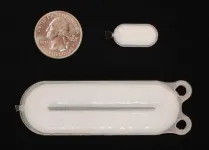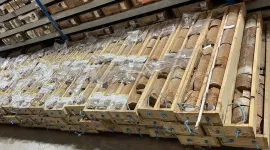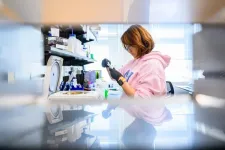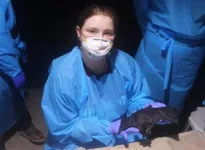(Press-News.org) ORLANDO, Nov. 27, 2023 – Three research projects from the University of Central Florida have been selected for NASA Minority University Research and Education Project Partnership Annual Notification (MPLAN) awards. The grants, worth up to $50,000 each, are designed to connect and promote research collaborations between Minority Serving Institutions and NASA Mission Directorates.
A total of 18 projects received Phase I funding across 15 universities. UCF received the most awards, with all three housed within the College of Engineering and Computer Science. Dean Michael Georgiopoulos says this speaks to the quality of research produced by CECS faculty.
“I’m proud to see that three of our research teams have been recognized by NASA for their innovative ideas that can shape the future of air travel and space flight,” Georgiopoulos says. “Our college has built a rich history with NASA and this award further solidifies the partnership between our respective researchers.”
All Phase I award recipients will be eligible to compete for Phase II funding and University Leadership Initiatives and Small Business Innovation Research/Small Business Technology Transfer (SBIR/STTR) grants. Learn more about the projects below.
Project Title: Multimodal Wireless Piezoelectric Microsensors
Award Amount: $50,000
Researchers: Reza Abdolvand and Hakhamanesh Mansoorzare
The third time was the charm for the Artemis I launch. After two unsuccessful launch attempts due to dangerously high engine temperatures, a crack in the fuel tank insulation and multiple fuel leaks, the rocket finally soared into orbit off the Space Coast.
To prevent these issues from delaying future Artemis missions or other NASA space explorations, a team of UCF researchers is developing a wireless multimodal sensor module that can monitor conditions such as temperature, pressure, acceleration and airflow in real time.
The module, less than a cubic centimeter, will include multiple microelectromechanical systems (MEMS) resonators that will measure those conditions. MEMS resonators are often used for motion sensing, time referencing and signal filtering in electronic devices but show promise in the aerospace engineering field due to their light weight, highly accurate readouts and cost-effective manufacturing.
Although the sensors will be roughly the size of a pencil eraser, they will be able to withstand extreme temperatures since there is no battery or electronics in the device. This will be the first wireless multimodal sensor of its kind.
“Piezoelectric MEMS resonators can detect change in environmental parameters without the need for any auxiliary power source such as battery as they could be powered wirelessly by a remote transceiver unit,” says Reza Abdolvand, professor and chair of the Department of Electrical and Computer Engineering. “This will create a unique opportunity for development of compact and battery-less sensing units that could withstand a harsh environment.”
Once manufactured, the sensing system can be used across various NASA missions to detect dangerous temperatures in critical spacecraft components, monitor the pressure in fuel tanks to prevent leaks, measure the temperature and pressure of lunar regolith, and assess the climate conditions for takeoff.
Project Title: SUPERSAF-SAF for Low Emission Supersonic Transport
Award Amount: $50,000
Researchers: Subith Vasu, Justin Urso, Ramees Khaleel Rahman, Gihun Kim
Supersonic commercial aircraft may be able to fly faster than the speed of sound and reduce the time for transatlantic journeys considerably, but their ultra-fast flights powered by fossil fuels could have a harmful effect on the environment. Mechanical and Aerospace Engineering Professor Subith Vasu and his team of postdoctoral scholars aim to protect the environment by studying the emissions of sustainable aviation fuels (SAFs), a greener alternative made from sustainable resources such as wood residues, fatty acids, fermented sugars and processed alcohols.
Several government agencies have started to test these fuels for emissions, but the process is costly and doesn’t measure the output of nitrogen oxides (NOx) or the formation of soot, both of which can pollute the air, contribute to the formation of acid rain, and even cause respiratory issues in humans.
The team in the Vasu Lab will conduct shock tube experiments to test the NOx and soot emissions of several different SAFs. That data will be used to improve the aviation industry’s and NASA’s current chemical kinetic models that can predict the soot and NOx output of various SAFs in flight conditions.
“SAFs can reduce carbon dioxide emissions by up to 80%, but not all SAFs produce lesser soot and NOx compared to traditional jet fuels,” Vasu says. “The data we collect could significantly improve the current chemical kinetic model and advance the production of combustors for supersonic flights.”
The research is timely, given NASA recently awarded contracts to both Boeing and Northrop Grumman to develop technology roadmaps and concept vehicles for supersonic aircraft. Vasu plans to work with industry partners on this research and to seek additional funding from NASA beyond the MPLAN grant.
Project Title: A CNS Digital Twin Framework for AAM
Award Amount: $50,000
Researcher: Adan Vela
Airplanes and helicopters are often spotted in the sky, but in the future, cargo-loaded drones and passenger-carrying air taxis might become a common sight. Through NASA’s Advanced Air Mobility (AAM) mission, the organization aims to create a safe and accessible aerial transportation system that can send cargo or people to hard-to-reach areas or even tourist destinations.
However, before AAM can take flight, engineers must address fundamental challenges of the communication, navigation and surveillance (CNS) system that supports control, command and collision of these vehicles, as they could face challenges from the low altitude at which they fly or the lack of a human pilot. Buildings or terrain could distort or delay important CNS signals such as GPS or 5G.
To better understand this problem, Industrial Engineering and Management Systems Assistant Professor Adan Vela will develop the CNS-AAM simulation engine, a digital twin framework that mimics the CNS system that the AAM would require. With the aid of computer science students, Vela will create the simulation engine in Python. The resulting framework will allow NASA, the FAA and researchers around the world to digitally develop and test new artificial intelligence algorithms that manage aircraft and CNS technologies, including cybersecurity measures that could protect UAVs from malicious attacks.
Writer: Marisa Ramiccio, University of Central Florida College of Engineering and Computer Science
END
UCF receives 3 minority serving institution awards to promote collaborations with NASA
The funding is designed to foster long-term partnerships between NASA and MSIs and to give eligible research projects the chance to pursue larger grants in the future
2023-11-27
ELSE PRESS RELEASES FROM THIS DATE:
Stem cell-based treatment controls blood sugar in people with Type 1 diabetes
2023-11-27
An innovative stem cell-based treatment for Type 1 diabetes can meaningfully regulate blood glucose levels and reduce dependence on daily insulin injections, according to new clinical trial results from the University of British Columbia (UBC) and Vancouver Coastal Health (VCH).
“This is a significant step toward a functional cure for Type 1 diabetes,” said Dr. David Thompson, principal investigator at the Vancouver trial site, clinical professor of endocrinology at UBC and director of the Vancouver General Hospital Diabetes Centre. ...
Wave Devouring Propulsion: a revolutionary green technology for maritime sustainability
2023-11-27
A new form of wave devouring propulsion (WDP) could power ships and help to cut greenhouse gas emissions in the maritime industry.
Academics from Cranfield University have worked on the concept of using wave energy for propulsion, and designed an inventive method of achieving greater thrust from the power of the waves by harnessing a vessel’s submerged flapping foils in an innovative way.
Inspiration from whale fins
Taking inspiration from the power of a whale's fins, the team studied the structure and movement of the tail fin to unravel how it effectively uses wave energy for propulsion. Through simulations and experiments, they developed ...
Algorithmic recommendation technology or human curation? Study of online news outlet in Germany suggests both
2023-11-27
Recommender systems are machine learning applications in online platforms that automate tasks historically done by people. In the news industry, recommender algorithms can assume the tasks of editors who select which news stories people see online, with the goal of increasing the number of clicks by users, but few studies have examined how the two compare.
A new study examined how users of an online news outlet in Germany reacted to automated recommendations versus choices made by human editors. On average, the algorithm outperformed the person, but the person did better under certain conditions. The study’s authors suggest a combination of human curation and automated recommender ...
BU study finds breast density discussions with clinicians varied significantly by race/ethnicity and literacy level
2023-11-27
(Boston)—Breast density information aims to increase awareness of breast density and its risks and inform future breast screening decisions. Breast density notifications (BDN) advise women to discuss breast density with their clinicians, but prior research shows less than half of women in the general population have those conversations and little is known about the content of conversations that do occur.
A new study by researchers from Boston University Chobanian & Avedisian School ...
Alien haze, cooked in a lab, clears view to distant water worlds
2023-11-27
Scientists have simulated conditions that allow hazy skies to form in water-rich exoplanets, a crucial step in determining how haziness muddles observations by ground and space telescopes.
The research offers new tools to study the atmospheric chemistry of exoplanets and will help scientists model how water exoplanets form and evolve, findings that could help in the search for life beyond our solar system.
“The big picture is whether there is life outside the solar system, but trying to answer that kind of question requires really detailed modeling of all different types, specifically in planets with lots of water,” said co-author ...
Deoxygenation levels similar to today’s played a major role in marine extinctions during major past climate change event
2023-11-27
Scientists have made a surprising discovery that sheds new light on the role that oceanic deoxygenation (anoxia) played in one of the most devastating extinction events in Earth’s history. Their finding has implications for current day ecosystems – and serves as a warning that marine environments are likely more fragile than apparent.
New research, published today in leading international journal Nature Geosciences, suggests that oceanic anoxia played an important role in ecosystem disruption and extinctions in marine environments during the Triassic–Jurassic mass extinction, ...
Fish IgM structure sheds light on antibody evolution, study finds
2023-11-27
Antibodies—proteins that are produced by our immune system to protect us—are crucial for recognizing and getting rid of unwanted substances, or antigens, in our body. Although their role is universal, antibody structure varies in different animals. In a new study, researchers have analyzed the antibody Immunoglobulin M in rainbow trout to shed some light on why these proteins may have evolved over time.
In humans, IgM consists of five repeating units that are held together by a joining chain, resulting in a star shape. Consequently, IgM can bind to multiple antigens at the ...
Wind and solar projects can profit from bitcoin mining
2023-11-27
ITHACA, N.Y. – Bitcoin mining is often perceived as environmentally damaging because it uses huge amounts of electricity to power its intensive computing needs, but a new study demonstrates how wind and solar projects can profit from bitcoin mining during the precommercial development phase — when a wind or solar farm is generating electricity, but has not yet been integrated into the grid.
The findings suggest some developers could recoup millions of dollars to potentially invest in future renewable energy projects.
The ...
Vampire bats make northward flight seeking stable climates
2023-11-27
Vampire bats may soon take up residence in the United States and bring with them an ancient pathogen.
“What we found was that the distribution of vampire bats has moved northward across time due to past climate change, which has corresponded with an increase in rabies cases in many Latin American countries,” said Paige Van de Vuurst, a Ph.D. student in Virginia Tech’s Translational Biology, Medicine, and Health Graduate Program.
Van de Vuurst is the lead author of research recently published in the Ecography journal that predicts ...
New method uses crowdsourced feedback to help train robots
2023-11-27
To teach an AI agent a new task, like how to open a kitchen cabinet, researchers often use reinforcement learning — a trial-and-error process where the agent is rewarded for taking actions that get it closer to the goal.
In many instances, a human expert must carefully design a reward function, which is an incentive mechanism that gives the agent motivation to explore. The human expert must iteratively update that reward function as the agent explores and tries different actions. This can be time-consuming, inefficient, ...
LAST 30 PRESS RELEASES:
A new way to map how cells choose their fate
Numbers in our sights affect how we perceive space
SIMJ announces global collaborative book project in commemoration of its 75th anniversary
Air pollution exposure and birth weight
Obstructive sleep apnea risk and mental health conditions among older adults
How talking slows eye movements behind the wheel
The Ceramic Society of Japan’s Oxoate Ceramics Research Association launches new international book project
Heart-brain connection: international study reveals the role of the vagus nerve in keeping the heart young
Researchers identify Rb1 as a predictive biomarker for a new therapeutic strategy in some breast cancers
Survey reveals ethical gaps slowing AI adoption in pediatric surgery
Stimulant ADHD medications work differently than thought
AI overestimates how smart people are, according to HSE economists
HSE researchers create genome-wide map of quadruplexes
Scientists boost cell "powerhouses" to burn more calories
Automatic label checking: The missing step in making reliable medical AI
Low daily alcohol intake linked to 50% heightened mouth cancer risk in India
American Meteorological Society announces Rick Spinrad as 2026 President-Elect
Biomass-based carbon capture spotlighted in newly released global climate webinar recording
Illuminating invisible nano pollutants: advanced bioimaging tracks the full journey of emerging nanoscale contaminants in living systems
How does age affect recovery from spinal cord injury?
Novel AI tool offers prognosis for patients with head and neck cancer
Fathers’ microplastic exposure tied to their children’s metabolic problems
Research validates laboratory model for studying high-grade serous ovarian cancer
SIR 2026 delivers transformative breakthroughs in minimally invasive medicine to improve patient care
Stem Cell Reports most downloaded papers of 2025 highlight the breadth and impact of stem cell research
Oxford-led study estimates NHS spends around 3% of its primary and secondary care budget on the health impacts of heat and cold in England
A researcher’s long quest leads to a smart composite breakthrough
Urban wild bees act as “microbial sensors” of city health.
New study finds where you live affects recovery after a hip fracture
Forecasting the impact of fully automated vehicle adoption on US road traffic injuries
[Press-News.org] UCF receives 3 minority serving institution awards to promote collaborations with NASAThe funding is designed to foster long-term partnerships between NASA and MSIs and to give eligible research projects the chance to pursue larger grants in the future




